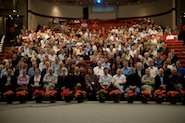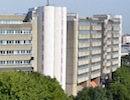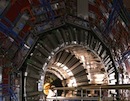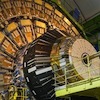Joint institute of ULB and VUB
Located in Brussels
IIHE and the Nobel Prize in Physics
The IIHE participation to the CMS experiment
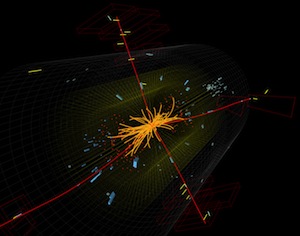
An event display of four muons in the CMS detector
The Compact Muon Solenoid (CMS), is one of the two general purpose detectors, located at the proton-proton collider at CERN, the Large Hadron Collider (LHC). The main purposes of the LHC are the discovery and the study the famous Brout-Englert-Higgs boson and the search for other new particles predicted by new theories beyond the Standard Model. The LHC is a discovery machine! It will also allow physicists to precisely measure Standard Model parameters and to study rare processes.
Belgium and in particular Brussels (ULB-VUB) has an important participation in the CMS project. The Brussels group has participated in the contruction of the endcap tracker detector of CMS, in the data taking and detector calibration, and was involved in the study of the CMS physics potential using simulations. The IIHE teams are now analysing the LHC data taken in 2011 and 2012 at the energy of 7 and 8 TeV in the proton-proton centre of mass, and are preparing the new high-energy run at 13 TeV foreseen in 2015. In parallel, the group is also doing research and development in view of the upgrade of the detector.
The CMS Brussels group is very active in the high energy data analysis in many different final states. It is involved in the study of the Brout-Englert-Higgs particle decaying into ditau or diboson final states, top quark properties measurements and search for new phenomena in the top sector, search for new heavy resonances with multilepton topologies, and tests of QCD.
For more details see the IIHE CMS page or the CMS home page.
The IIHE and the scalar boson
The IIHE team contributes to the study of scalar particles in the following ways:
- The team at the IIHE measure important properties of the newly-discovered scalar boson with mass ~ 126 GeV. In particular, they measure the rate at which the scalar boson decays into matter particles called tau leptons. In the Standard Model of particle physics, this decay rate is related to the mass of the tau leptons. A precise confirmation of the expected coupling is very important, a deviation would indicate new, yet unknown physics. We also search for decays of the scalar boson into particles that could compose the dark matter of the universe.
- The team also search for additional, more massive scalar bosons. Theory assigns very special properties to the light scalar boson, but it does not forbid the presence of additional particles with similar characteristics. Searching for these particles is complementary to measuring the properties of the newly-discovered boson.
Other research at the IIHE
The institute is also involved on other activities and experiments, as summarised below.
IceCube experiment at the South Pole
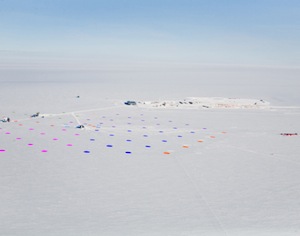
Overview of the IceCube site
The IIHE plays an active role in the IceCube experiment, a huge neutrino observatory based in Antarctica. The observatory itself is a cubic kilometre in size and contains more than 5,000 optical sensors located deep in the ice. IceCube can explore a whole new range of new phenomena, including very high energy neutrinos from beyond the galaxy.
For more details see the IIHE IceCube page or the IceCube home page.
Instrumentation

A micro-TCA advanced mezzanine board, made at the IIHE
Since its creation, the IIHE has always been involved both in the research and development (R&D) programs and in the data analysis of major experiments in high energy physics (Gargamel, UA1, Delphi at LEP, Chorus, H1 at DESY, Amanda, IceCube, Opera, CMS at LHC, etc.). Since 2007, the IIHE focuses its R&D activities on digital electronics, trigger and data acquisition systems for the upgrades of the CMS experiment and future experiments like ARA and the future linear collider.
For more details see the IIHE Instrumentation page.
Frontier computing at the GRID
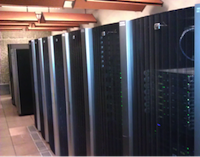
The Brussels T2 cluster
The IIHE hosts a Tier 2 cluster for the globally distributed computing network, known as the GRID. There are six people responsible for support of the group and for the smooth running of the cluster, which is used by collaborators across the world. As of April 2012, the Brussels site routinely serves 20,000 jobs of 1.5h average duration per day. Belgian physicists perform a large fraction of their computer-intensive simulations and data analyses on the LHC Grid.
For more details see the CERN LHC Computing Grid page.
Other experiments
The H1 collaboration performs studies of electron-proton interactions at the HERA collider which operated from 1992 to 2007, with the main interests being the proton structure in a wide kinematic range. The OPERA experiment studied tau neutrino appearance and neutrino oscillation phenomena using a high energy high intensity neutrino beam which produced using the SPS at CERN. The IIHE is currently active in both of these experiments.
For more details see the IIHE H1 page and IIHE OPERA page.
See also:
Research opportunities
Candidates with an excellent scientific profile can contact us all year to apply for a PhD scholarship: iihe-jobs@listserv.ulb.ac.be
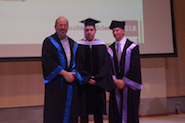
BND School 2013
In August 2013 IIHE hosted the BND school, which brings together young scientists from Belgium, Germany and the Netherlands.

CMS Week 2011
In September 2011 IIHE hosted the CMS Week, which brought together hundreds of collaborators from many different nations to Brussels.
